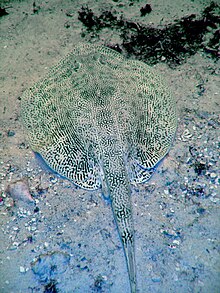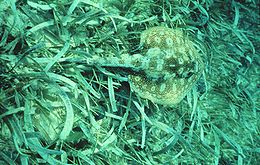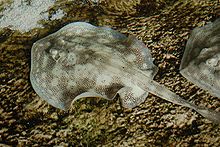Yellow stingray
| Yellow stingray | |
|---|---|

| |
| Scientific classification | |
| Domain: | Eukaryota |
| Kingdom: | Animalia |
| Phylum: | Chordata |
| Class: | Chondrichthyes |
| Subclass: | Elasmobranchii |
| Superorder: | Batoidea |
| Order: | Myliobatiformes |
| Family: | Urotrygonidae |
| Genus: | Urobatis |
| Species: | U. jamaicensis
|
| Binomial name | |
| Urobatis jamaicensis (Cuvier, 1816)
| |

| |
| Range of the yellow stingray | |
| Synonyms | |
The yellow stingray (Urobatis jamaicensis) is a species of
Female yellow stingrays are larger than males. Females reach about a maximum length of about 26 inches whereas the male will reach a maximum legth of about 15 inches across. The yellow stingray has a round
Relatively sedentary during the day, the yellow stingray feeds on small
Taxonomy and phylogeny
French
Nathan Lovejoy's 1996
Description

The yellow stingray is small, growing no more than 36 cm (14 in) across and 70 cm (28 in) long.
The tail is stout and flattened, comprising less than half the total length, and terminates in a small, leaf-shaped
Distribution and habitat

The yellow stingray is found throughout the inshore waters of the
Biology and ecology

During the day, the yellow stingray is fairly inactive and spends much time buried under a thin layer of sediment or lying motionless in vegetation.
The diet of the yellow stingray is poorly documented but includes
The yellow stingray exhibits
Life history

Like other stingrays, the yellow stingray is
Courtship and mating in the yellow stingray involves one or more males closely following a female, seeking to bite and grip the rear margin of her disc; the high, pointed teeth of males serve to aid in this endeavor. Once the male successfully holds onto the female, he flips under her so that the two are aligned abdomen-to-abdomen, and inserts a single clasper into her cloaca. Rival males may attempt to interfere with the mating pair by biting or bumping them. In one observation that took place in water 2.5 m (8.2 ft) deep near Tobacco Caye on the Belize Barrier Reef, the male pursuit lasted between 30 and 60 seconds and copulation lasted four minutes.[13][17]
The predominant source of embryonic nutrition is histotroph, which supports a 46-fold weight increase from ovum to near-term
Human interactions

Generally, yellow stingrays pay little heed to divers and can be approached closely.[8] If stepped on or otherwise provoked, however, this ray will defend itself with its tail spine, coated in potent venom. The resulting wound is extremely painful, but seldom life-threatening.[3][9] Small and docile, the yellow stingray adapts readily to captivity and has reproduced in the aquarium; it requires a large amount of space (at least 180 gal or 684 L) and a fine, deep substrate with minimal ornamentation.[17]
The
Gallery
-
A yellow stingray swimming over rubble.
-
A yellow stingray resting on a reef inMiami, Florida.
-
A yellow stingray at the Oregon Coast Aquarium in Newport, Oregon.
-
A yellow stingray swimming over a sandy substrate.
-
A yellow stingray resting under a layer of sand inCozumel, Mexico.
-
A yellow stingray behind a gorgonian.
References
- ^ doi:10.2305/IUCN.UK.2020-3.RLTS.T60109A124438908.en. Retrieved 16 November 2021.)
{{cite journal}}: CS1 maint: multiple names: authors list (link - ^ Eschmeyer, W. N. (ed.) jamaicensis, Raia Archived 2012-02-21 at the Wayback Machine. Catalog of Fishes electronic version (19 February 2010). Retrieved on March 21, 2010.
- ^ a b c d e f g h Piercy, A. Biological Profiles: Yellow Stingray. Florida Museum of Natural History Ichthyology Department. Retrieved on November 15, 2008.
- .
- S2CID 52477747.
- ^ ISBN 92-5-104825-8.
- ^ ISBN 0-292-75206-7.
- ^ ISBN 1-55209-629-7.
- ^ ISBN 1-57806-827-4.
- ISBN 0-8050-0733-4.
- ISBN 0-7637-3313-X.
- ^ a b Fahy, D.P. and R.E. Spieler. Activity patterns, distribution and population structure of the yellow stingray, Urobatis jamaicensis in Southeast Florida (abstract). American Elasmobranch Society 2005 Annual Meeting, Tampa, Florida.
- ^ JSTOR 1447257.
- PMID 18245624.
- S2CID 35514231.
- ^ Walker, B.K. & R.L. Sherman (2001). "Gross brain morphology in the yellow stingray, Urobatis jamaicensis" (PDF). Florida Scientist. 64 (4): 246–249. Archived from the original (PDF) on 2011-06-09. Retrieved 2010-03-25.
- ^ ISBN 1-890087-57-2.
- PMID 29105768.
- .
- S2CID 28259982.
- S2CID 84577956.
- PMID 24421880.
- ^ a b c d Fahy, D.P.; R.E. Spieler & W.C. Hamlett (2007). "Preliminary observations of the reproductive cycle and uterine fecundity of the yellow stingray, Urobatis jamaicensis (Elasmobranchii: Myliobatiformes: Urolophidae) in Southeast Florida, U.S.A." (PDF). The Raffles Bulletin of Zoology. Supplement 14: 131–139. Archived from the original (PDF) on 2010-05-28. Retrieved 2010-03-22.
- doi:10.1002/(SICI)1097-010X(199811/12)282:4/5<438::AID-JEZ4>3.3.CO;2-Y. Archived from the originalon 2013-01-05.
- PMID 21714110.
- ^ Animals: Yellow Stingray Archived 2014-10-28 at the Wayback Machine. Pittsburgh Zoo & PPG Aquarium. Retrieved on March 25, 2010.
External links
- "Urobatis jamaicensis, Yellow stingray" at FishBase
- "Biological Profiles: Yellow Stingray" at Florida Museum of Natural History
- Photos of Yellow stingray on Sealife Collection







